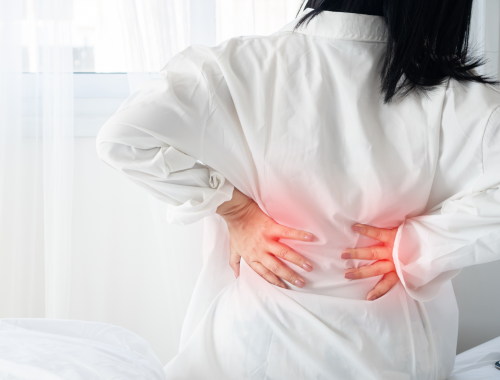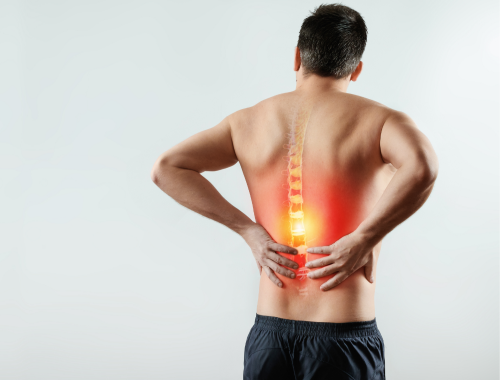Difference Between Sciatica and Lower Back Pain

It can take 3 to 6 months for sciatica (pain impacting the back, hip, and outer side of the leg) to go away after an acute attack. In contrast to sciatica (pain impacting the back, hip, and outer side of the leg), lower back pain can result from a variety of conditions, such as minor mishaps (minor injuries), inadequate sleep (insomnia), or even unexpected movements. Both pains occur in the occur in the lumbar spine (lower region of the back).

Similarity
Both lower back pain and sciatic are classifications of lower back pain
Sciatica
Sciatica (sciatic neuritis) is a term for leg discomfort, achiness, numbness (pins and needles), or tingling. It is brought on by pressure, compression or damage to the sciatic nerve (starts in the lower back and travels down the back of each leg). Sciatica is an indication and a sign of a health problem. It is not a disease/illness in and of itself.
Lower back pain
Lower back pain is a common problem in men and women. There are multiple reasons that cause lower back pain like strain (injury), compression of tendons, nerves and muscles in the back, disk injuries and arthritis. Some symptoms and pain can be relieved by rest, pain killers and physical therapy and medication.
Difference between Sciatica and Lower back pain
Definition
Sciatica
Sciatica (sciatic neuritis) is a term for leg discomfort, achiness, numbness (pins and needles), or tingling.
Lower back pain
Lower back pain is a common problem in men and women. There are multiple reasons that cause lower back pain like strain (injury), compression of tendons, nerves and muscles in the back, disk injuries and arthritis.
Causes
Sciatica
- Herniation from age-related changes in the spine (also known as slipped disc or disc prolapse)
- Muscle spasms compressing the sciatic nerve
- Conditions caused by spinal degeneration, such as spinal stenosis
Lower back pain
- Lower back pain
- Strain injury
- Sciatica
- Spinal stenosis
- Unusual spine curvatures
- Herniated disc
- Being overweight
- Lifting very heavy items
- Arthritis
- Fibromyalgia
- Spondylitis
- Spondylosis
Treatment
Sciatica
- Cold packs
- Hot packs – apply heat to the areas that are sore and hurt
- Stretching
- Medications to give relief from the pain
Lower back pain
- Cortisone injections
- Rest, pain relievers and physical therapy (PT).
Summary
The points of difference between Sciatica and Lower back pain have been summarized as below:

FAQ:
How do I know if my back pain is sciatica?
Sciatica (pain impacting the back, hip, and outer side of the leg) is the most likely reason if your uneasiness begins in your back and travels or radiates (spread from or as if from a central point) to your hip your hip (the area below the waist) or down your leg, or if you have numbness (a loss of feeling in a part of the body), tingling, or weakness.
What does sciatica feel like in lower back?
Pain from sciatica can vary greatly. It could have a slight tingling, aching, or burning sensation. In rare instances, the agony is so bad that it renders a person immobile. The pain typically only affects one side.
What else could it be if it’s not sciatica?
Sciatica (pain impacting the back, hip, and outer side of the leg) is frequently confused with piriformis syndrome (it happens when piriformis muscle in the buttocks irritates the sciatic nerve). While the sciatic nerve (starts in the lower back and travels down the back of each leg) is affected by both disorders, sciatica is caused by spinal problems such a herniated disc (also called bulged, slipped or ruptured) or spinal stenosis.
How can you tell the difference between sciatica and muscle pain?
A severe shooting and acute pain known as sciatica (pain impacting the back, hip, and outer side of the leg) is a disorder brought on by strain on the sciatic nerve. Muscle spasms (involuntary contractions of a muscle) can have many different origins, are characterised by excruciating pain and stiffness, and may even increase the risk of sciatica.
What are 2 symptoms of sciatica?
- Lower back pain
- Muscle spasms in the back
What is the fastest way to heal sciatica?
- Physical therapy
- Hot and cold packs
Does walking help sciatica?
Walking is actually beneficial for sciatica, despite the fact that it undoubtedly hurts to some extent. Doctors have made the observation that walking increases blood flow throughout the body and may even strengthen the nerves.
What is the straight leg test for sciatica?
SLR test, or straight leg raise test can be done to test for sciatica. The patient can lie down upside down or on his or her back for this examination, elevating one leg at a time while keeping the other flat or bent at the knee. Sciatica is typically diagnosed when the affected leg hurts when it is lifted.
What is best sleep position for sciatica?
The best sleep position for sciatica is on the back: According to research, many patients experience pain relief when they sleep on their backs. The sciatic nerve and low back pressure may be relieved as a result. Elevate the knees by putting one or more pillows underneath them for the best effects. Make sure a pillow is used to support the neck as well.
- Difference Between Global Warming and Greenhouse Effect - May 18, 2024
- Difference Between Vaccination and Immunization - March 3, 2024
- Difference Between Selective Mutism and Autism - February 25, 2024
Search DifferenceBetween.net :
Leave a Response
References :
[0]Hoy, D., Brooks, P., Blyth, F., & Buchbinder, R. (2010). The epidemiology of low back pain. Best practice & research Clinical rheumatology, 24(6), 769-781.
[1]Koes, B. W., Van Tulder, M. W., & Peul, W. C. (2007). Diagnosis and treatment of sciatica. Bmj, 334(7607), 1313-1317.
[2]Ropper, A. H., & Zafonte, R. D. (2015). Sciatica. New England Journal of Medicine, 372(13), 1240-1248.
